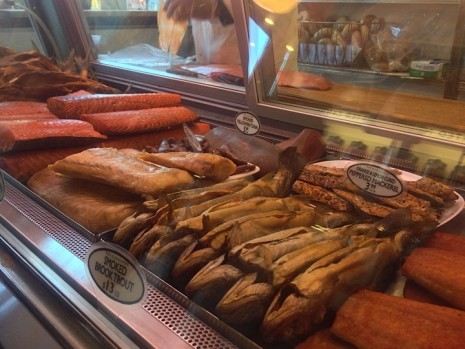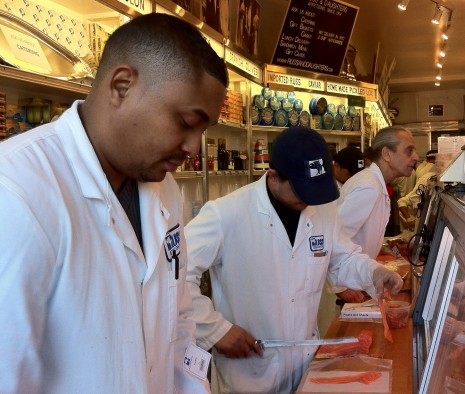SMOKED FISH: YOUR HOLIDAY GUIDE TO SHOPPING & EATING
Holiday entertaining has a certain glamour about it. And although a magnificent standing rib roast, for instance, or a caramel-caged croquembouche are tried-and-true showstoppers, the extravagance and formality they represent are an uneasy fit for many of us these days. There’s the expense and time involved, obviously, but also lighter, leaner diet preferences, or a hectic life in which a relaxed lunch or cosy Sunday supper is more achievable—and appealing— than an elaborate meal.
That’s why my go-to delicacy for the past few years has been smoked fish. It is chic and versatile: For brunch, say, you can serve paper-thin slices of smoked salmon with cream cheese, butter, and assorted bagels and Eastern European–style dark bread, or, for a first course at lunchtime or supper, drape a few glistening slices of gravlax on small plates with a dollop of a dill or mustard sauce. You can buy a whole salmon fillet that’s been sliced and then reassembled on the bone—very nice for a buffet—or add coarse flakes of smoked chub or trout to a horseradish dip, a salad of watercress and crisp apple, or bowls of hot borscht. And don’t forget about Danish smørrebrød, the open-faced sandwiches eaten with knife and fork. This one, from The Gourmet Cookbook, is made with smoked salmon and scrambled eggs, and is reason alone to keep a few bottles of Tuborg or Carlsberg in the house. We had it just the other night, after we came home late-ish from a cocktail party. Then we went to bed and slept like lambs.
My favorite purveyor is the renowned Russ & Daughters, on Houston Street. Founded in 1914 by Joel Russ, it is the quintessential Jewish-American “appetizing store”—specializing in all manner of mouthwatering preserved fishes (there’s a sampling in the top photo), dairy products, and confections. Not being a native New Yorker, I first learned about the shop in the 1970s, when Calvin Trillin started writing about it in his food pieces for The New Yorker.
Russ & Daughters is now headed up by the fourth generation of Federmans, and in Trillin’s marvelous foreword to Mark Russ Federman’s memoir, Russ & Daughters: Reflections and Recipes from the House That Herring Built (published this year by Schocken), he noted that the smoked salmon is still sliced by now-manager Herman Vargas, a Yiddish-speaking Dominican who has worked at Russ & Daughters for more than 30 years. Herman produces “slices thin enough to read The New York Times through,” he wrote, then clarified: “Not the big-print edition; I’m talking about the regular.”
Whether you buy smoked fish from Russ & Daughters (they ship nationally, and, if you live within striking distance, are open Christmas Day and New Year’s Day) or another purveyor, below you’ll find a cheat sheet to the different styles and types of fish. In general, everything you see labeled “smoked salmon,” is cold-smoked, meaning the smoking takes place at below 90ºF (that sold at Russ & Daughters is smoked at 75°F). The gentleness of the technique results in fish with a silky texture, which allows for thin slicing. Most cold-smoked salmon, by the way, is made with farmed Atlantic salmon. Hot-smoking, on the other hand, literally cooks the fish at temperatures ranging from 150° to 170°F, which results in a flaky texture. In both cases, the fish is either “wet-cured” in a mild brine or “dry-cured” with a rub of salt and brown sugar before it’s smoked. And the color, which is not an indicator of quality or flavor, should range from pink to orange.
SALMON: CURED BUT NOT SMOKED
Gravlax: This salmon isn’t smoked but simply seasoned with salt, sugar, and dill, then weighted and refrigerated for a few days. As the salt and sugar penetrate the fish, excess moisture is drawn out, creating a brine. It has a characteristic tender, compact texture and rich yet clean flavor. Store-bought gravlax (literally “buried salmon”) is available, but you can make it at home, too. Serve it in ultrathin slices, with a dill- or mustard-based sauce, or on small, thin pieces of buttered brown bread.
Lox: Here, the salmon isn’t smoked, but salt-cured in an assertive brine; it needs the counterpoint of cream cheese and a bagel to bring out its best. It’s also absolutely delicious in lox chowder à la Russ & Daughters. The word lox, by the way, which is derived from the Yiddish laks and the German Lachs, simply means “salmon.” Because of its brine bath, lox is frequently whiter than the usual smoked salmon. Belly lox, from the fatty belly of the salmon, has a very full, salty, and surprisingly delicate flavor.
SALMON: CURED AND SMOKED
Irish: If you see wild Irish smoked salmon, pounce: It is superb—salmon and smoke at its most elemental. And the kind labeled “organic Irish salmon” is more deeply flavored than other farmed smoked salmons.
Kippered (baked) salmon: The hot-smoking process imparts a succulent texture and rich flavor to this appetizing classic. Pair it with a cold-smoked salmon for two different smoked-salmon experiences. It’s best to serve kippered salmon in a single thick piece (so it won’t fall apart) and let people cut off large, enjoyable forkfuls.
Norwegian: With a good balance of smoke and salt and a firm yet yielding texture, this is a terrific choice for people who are new to the world of smoked fish.
Nova: This term once referred to wild Atlantic salmon caught off Nova Scotia, or in the case of Gaspé Nova, from the Gaspé Peninsula, along the south shore of the St. Laurence River in Quebec. Today, though, with wild Atlantic salmon nearly extinct, the term more correctly refers to how the salmon is treated—first it’s briefly wet-brined, then gently smoked. Nova is the standard New York–style smoked salmon; it’s uniformly tender and mild.
Scottish: The genuine article—that is, salmon that has been caught (most likely, from a screened pen at a salmon farm), dry-brined, and smoked in Scotland—is smokier, firmer, and more distinctive than Nova. It makes a lovely first course, whether served on its own or shredded and tossed with pasta and cream sauce.
Wild Western or Pacific: The term wild salmon is nearly synonymous with Pacific salmon (you can meet the species here). They are more muscular (i.e., leaner) than farmed salmon, and contain more heart-healthy omega-3 fatty acids. The flavor is smoky, salmony, and more complex than any farmed salmon.
About whole sides of salmon: An entire side of salmon has a definite wow factor, and a purveyor like Russ & Daughters will trim and thinly slice whatever type of smoked salmon you choose, then reassemble it in presentation-ready form. And the firm of H. Forman & Son, Britain’s oldest salmon curer (and the last smokehouse in London’s East End) sells its luxurious “London cure” at Williams-Sonoma.
SPECIALTY FISH
Chub, whitefish, and cisco: These closely related fish, which come from the cold, deep lakes of North America, are becoming hard to find; as Mark Russ Federman explains in Russ & Daughters, their primary fishery, the Great Lakes, has been overrun by accidentally introduced non-indigenous species such as the zebra mollusk and the lamprey eel. Their flavor is rich, sweet, and smoky—well worth the effort of peeling back the skin, turned golden by hot-smoking, and removing the meat from the bones, leaving the fish frame intact. Enjoy, as Federman suggests, on a bed of lettuce accompanied by thick slices of tomato and onion, with a buttered slice of rye or pumpernickel bread or toasted bialy.
Sable: Smoked sable was once known as “poor man’s sturgeon,” sold on Manhattan’s Lower East Side for 70 cents a pound. Also known as black cod (which isn’t a true cod at all), it owes its buttery richness to its habitat—the deepest waters of the Bering Sea and Pacific Ocean, stretching from Alaska down to California, and its diet includes crab and squid. Sable can handle something spicy or sharp in flavor; try serving it with a horseradish sauce or even an olive relish or tapenade. It’s also wonderful flaked and tossed with potatoes and a lemon-spiked mayonnaise.
Sturgeon: Widely considered to be the crème de la crème of all smoked fish, hot-smoked sturgeon is firm, full-flavored, and velvety in texture. Most of what you’ll find in the United States is sustainably farmed.
Posted: December 17th, 2013 under Christmas, holiday gifts, winter.




